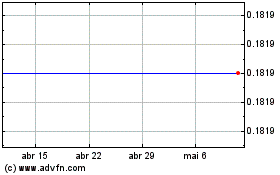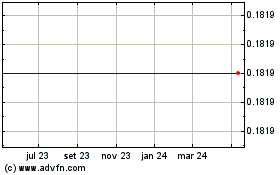By Suzanne Kapner and Andrew Scurria
J.C. Penney Co. dressed middle-class American families for more
than a century, but its failure to evolve as shopping habits
changed in the past decade set the retailer on a long march toward
bankruptcy.
On Friday, Penney filed for chapter 11 bankruptcy protection,
becoming the latest in a parade of retailers to seek a court
restructuring during the coronavirus pandemic. Neiman Marcus Group
Inc., J.Crew Group Inc. and Stage Stores Inc. have all filed for
bankruptcy this month.
Store shutdowns since March have choked off Penney's revenue,
putting more pressure on the company's lopsided balance sheet.
After years of falling sales, red ink and failed turnaround
efforts, the coronavirus pandemic hastened a reckoning with
creditors over its $3.8 billion in debt.
The company has been in discussions with some of its largest
lenders, including Sixth Street Partners and the credit-investing
arms of KKR & Co., Apollo Global Management Inc. and Ares
Management Corp., as well as H/2 Capital Partners Inc., people
familiar with the matter said.
Penney's sales, which totaled $10.7 billion in the most recent
fiscal year, have fallen each year since 2015, and it hasn't made
an annual profit in nearly a decade. The company skipped two
interest payments in recent weeks, setting the clock on a
bankruptcy filing.
The 118-year-old Penney is the latest American retailer to seek
bankruptcy protection as the rise of fast-fashion, off-price chains
like T.J. Maxx and e-commerce giants such as Amazon.com Inc. win
over younger shoppers. Other chains like Gap Inc. and Nordstrom
Inc. have recently raised billions of dollars in debt to ensure
they have the cash to weather the crisis and reopen stores.
Department stores have been particularly hard hit by the
changes. Stage Stores, which operates the Gordmans, Bealls and
Goody's chains in mostly rural towns, is liquidating hundreds of
stores when they reopen this month and looking for a buyer. Both
Macy's Inc. and Nordstrom are closing some of their flagship
stores.
Like its rival, Sears Holdings Corp., Penney for decades was a
one-stop shop for millions of middle-class families, offering
clothes, appliances, gardening equipment, portrait studios and
beauty salons. At one point, it owned a bank and the Eckerd
drugstore chain. It was a fixture in American shopping malls and at
its peak in the 1970s operated more than 1,600 stores. Today, there
are roughly 850 locations.
Founded in 1902 by James Cash Penney, the first store, in
Kemmerer, Wyo., was called the Golden Rule and sold textiles and
sundries. By 1913, with 36 locations, it changed its name to J.C.
Penney. It went public in 1929 amid the stock market crash. It
survived the Great Depression and after World War II opened
hundreds of stores in newly built suburban malls.
Before Sam Walton founded Walmart Inc., his first job in retail
was as a salesman at a Penney's in Des Moines, Iowa, in the early
1940s. "I worked for Penney's for about 18 months, and they really
were the Cadillac of the industry as far as I was concerned," Mr.
Walton recalled in his 1992 autobiography.
Penney published its first catalog in 1963. It became one of the
largest catalog publishers in the country after Sears shut its
catalog in 1993. Penney discontinued its "Big Book" in 2010 to
focus on e-commerce. But it made a push back into catalogs five
years later, after realizing that many online sales were inspired
by what shoppers saw in print.
Penney sold the Eckerd chain in 2004. Two years later, it formed
a partnership with beauty chain Sephora to open shops selling
makeup and skin care in Penney stores. Sephora was an important
deal for Penney, helping it woo a new set of shoppers. But it would
be one of the last successful moves by the chain.
In 2011, with sales flagging, it hired former Apple Inc.
executive Ron Johnson, who eliminated discounts in favor of
everyday low prices and dropped popular in-house brands. Shoppers
bolted. By the end of 2012, sales had fallen to $12.99 billion from
$17.26 billion a year earlier.
Former Home Depot Inc. executive Marvin Ellison took the reins
in 2015, but left three years later to become CEO of Lowe's Cos.
While at Penney, he brought back appliances, a category it had
exited in 1983. The appliance rollout took the focus off apparel,
Penney's core business, and sales suffered.
Like other department store chains, Penney had been trying to
attract younger shoppers. But it gave up on that goal to focus on
winning back middle-aged moms.
"They lost their core customer, and they have never been able to
get her back," said Chuck Grom, an analyst with Gordon Haskett
Research Advisors.
Jill Soltau, who has been CEO since 2018, refocused on apparel
and launched a test store in Texas with a fitness studio and
videogame lounge.
The company sold assets, including its Plano, Texas,
headquarters, to help reduce debt. By last year, its shares, which
had sunk below $1, were at risk of being delisted from the New York
Stock Exchange.
Shares closed Friday at 24 cents.
Write to Suzanne Kapner at Suzanne.Kapner@wsj.com and Andrew
Scurria at Andrew.Scurria@wsj.com
(END) Dow Jones Newswires
May 15, 2020 18:52 ET (22:52 GMT)
Copyright (c) 2020 Dow Jones & Company, Inc.
J C Penney (NYSE:JCP)
Gráfico Histórico do Ativo
De Abr 2024 até Mai 2024

J C Penney (NYSE:JCP)
Gráfico Histórico do Ativo
De Mai 2023 até Mai 2024
